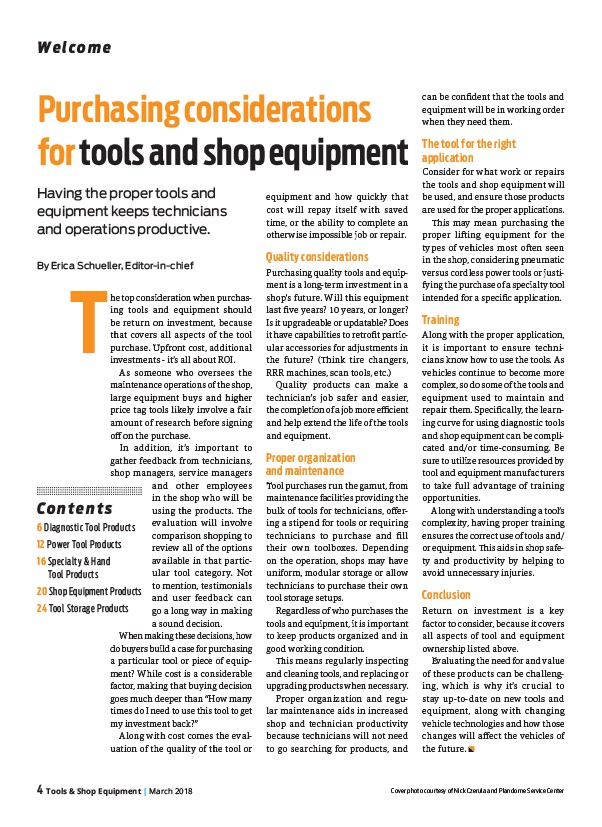
Welcome
he top consideration when purchasing
tools and equipment should
be return on investment, because
that covers all aspects of the tool
purchase. Upfront cost, additional
investments - it’s all about ROI.
As someone who oversees the
maintenance operations of the shop,
large equipment buys and higher
price tag tools likely involve a fair
amount of research before signing
off on the purchase.
In addition, it’s important to
gather feedback from technicians,
shop managers, service managers
and other employees
in the shop who will be
using the products. Th e
evaluation will involve
comparison shopping to
review all of the options
available in that particular
tool category. Not
to mention, testimonials
and user feedback can
go a long way in making
a sound decision.
When making these decisions, how
do buyers build a case for purchasing
a particular tool or piece of equipment?
While cost is a considerable
factor, making that buying decision
goes much deeper than “How many
times do I need to use this tool to get
my investment back?”
Along with cost comes the evaluation
of the quality of the tool or
4 Tools & Shop Equipment | March 2018
equipment and how quickly that
cost will repay itself with saved
time, or the ability to complete an
otherwise impossible job or repair.
Quality considerations
Purchasing quality tools and equipment
is a long-term investment in a
shop’s future. Will this equipment
last fi ve years? 10 years, or longer?
Is it upgradeable or updatable? Does
it have capabilities to retrofi t particular
accessories for adjustments in
the future? (Th ink tire changers,
RRR machines, scan tools, etc.)
Quality products can make a
technician’s job safer and easier,
the completion of a job more effi cient
and help extend the life of the tools
and equipment.
Proper organization
and maintenance
Tool purchases run the gamut, from
maintenance facilities providing the
bulk of tools for technicians, off ering
a stipend for tools or requiring
technicians to purchase and fi ll
their own toolboxes. Depending
on the operation, shops may have
uniform, modular storage or allow
technicians to purchase their own
tool storage setups.
Regardless of who purchases the
tools and equipment, it is important
to keep products organized and in
good working condition.
Th is means regularly inspecting
and cleaning tools, and replacing or
upgrading products when necessary.
Proper organization and regular
maintenance aids in increased
shop and technician productivity
because technicians will not need
to go searching for products, and
can be confi dent that the tools and
equipment will be in working order
when they need them.
The tool for the right
application
Consider for what work or repairs
the tools and shop equipment will
be used, and ensure those products
are used for the proper applications.
Th is may mean purchasing the
proper lift ing equipment for the
types of vehicles most oft en seen
in the shop, considering pneumatic
versus cordless power tools or justifying
the purchase of a specialty tool
intended for a specifi c application.
Training
Along with the proper application,
it is important to ensure technicians
know how to use the tools. As
vehicles continue to become more
complex, so do some of the tools and
equipment used to maintain and
repair them. Specifi cally, the learning
curve for using diagnostic tools
and shop equipment can be complicated
and/or time-consuming. Be
sure to utilize resources provided by
tool and equipment manufacturers
to take full advantage of training
opportunities.
Along with understanding a tool’s
complexity, having proper training
ensures the correct use of tools and/
or equipment. Th is aids in shop safety
and productivity by helping to
avoid unnecessary injuries.
Conclusion
Return on investment is a key
factor to consider, because it covers
all aspects of tool and equipment
ownership listed above.
Evaluating the need for and value
of these products can be challenging,
which is why it’s crucial to
stay up-to-date on new tools and
equipment, along with changing
vehicle technologies and how those
changes will aff ect the vehicles of
the future.
Purchasing considerations
for tools and shop equipment
T
Having the proper tools and
equipment keeps technicians
and operations productive.
By Erica Schueller, Editor-in-chief
Contents
6 Diagnostic Tool Products
12 Power Tool Products
16 Specialty & Hand
Tool Products
20 Shop Equipment Products
24 Tool Storage Products
Cover photo courtesy of Nick Czerula and Plandome Service Center